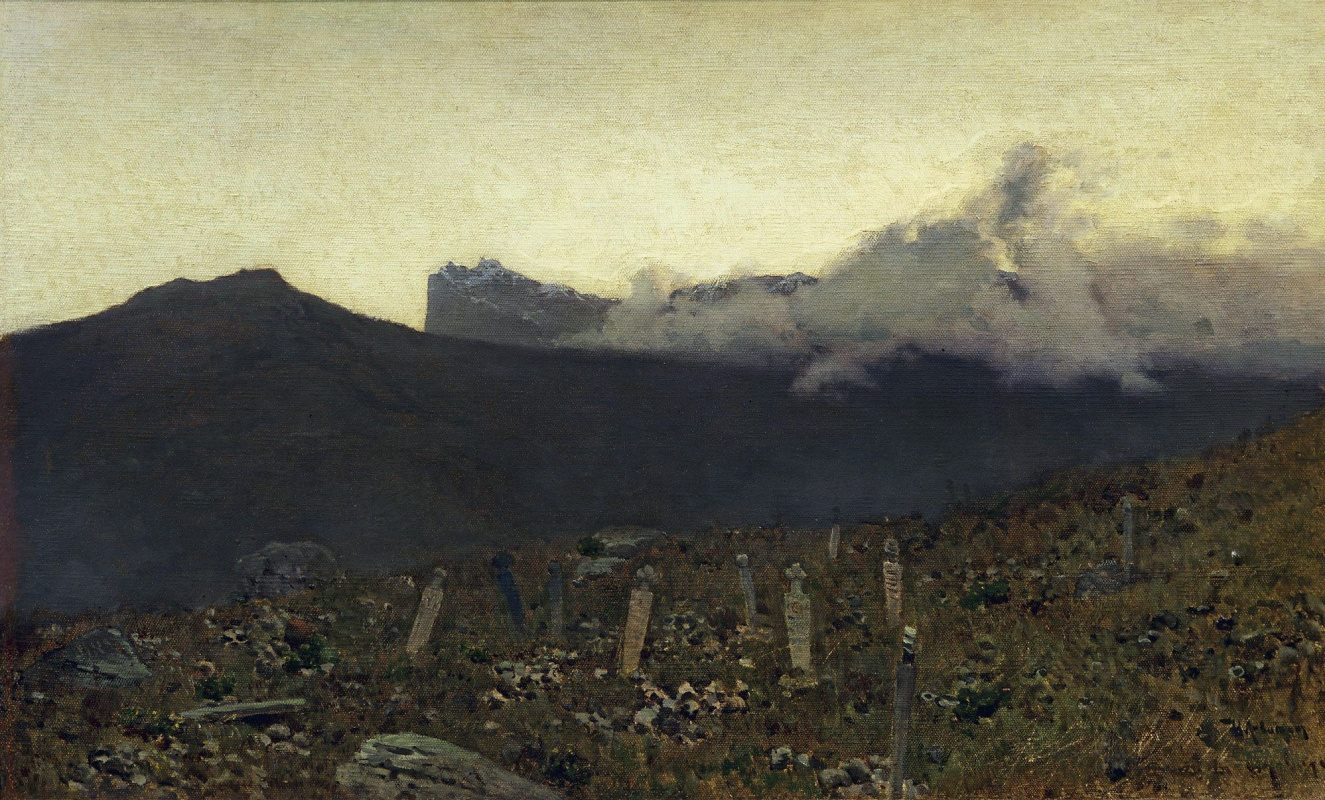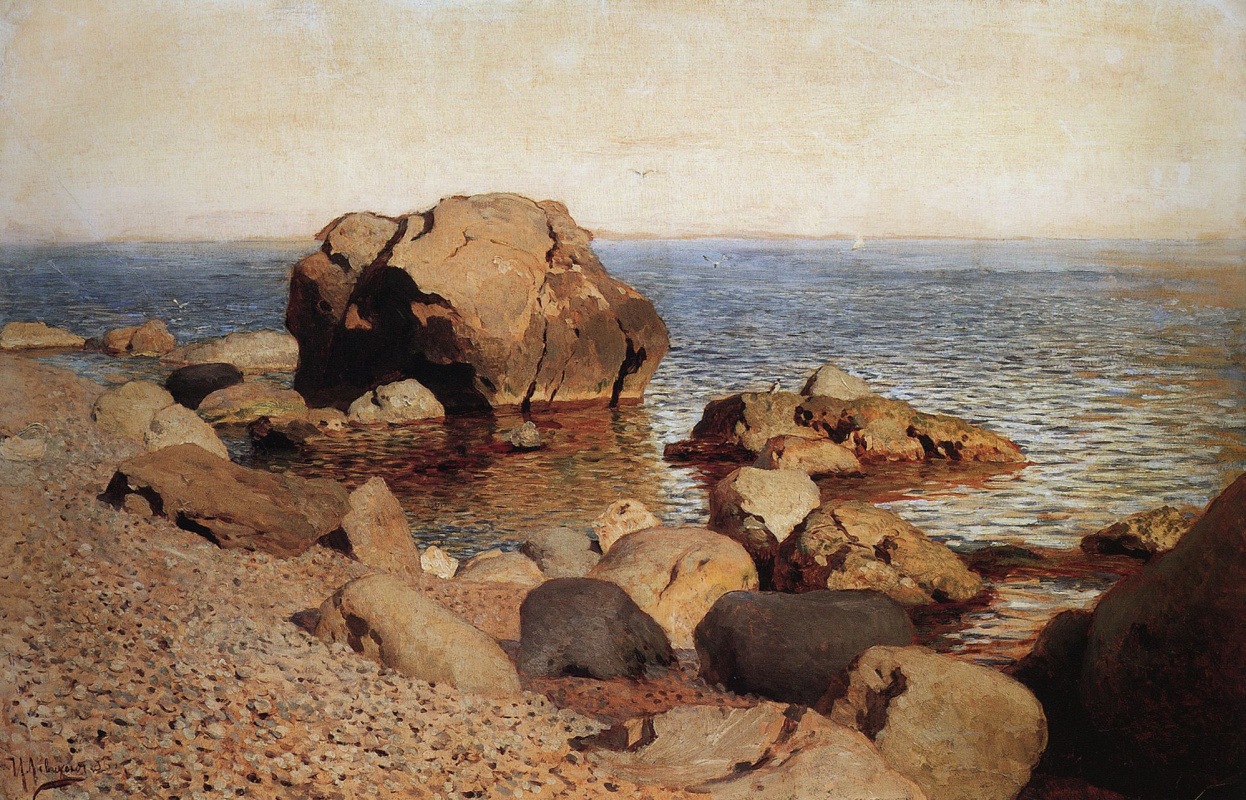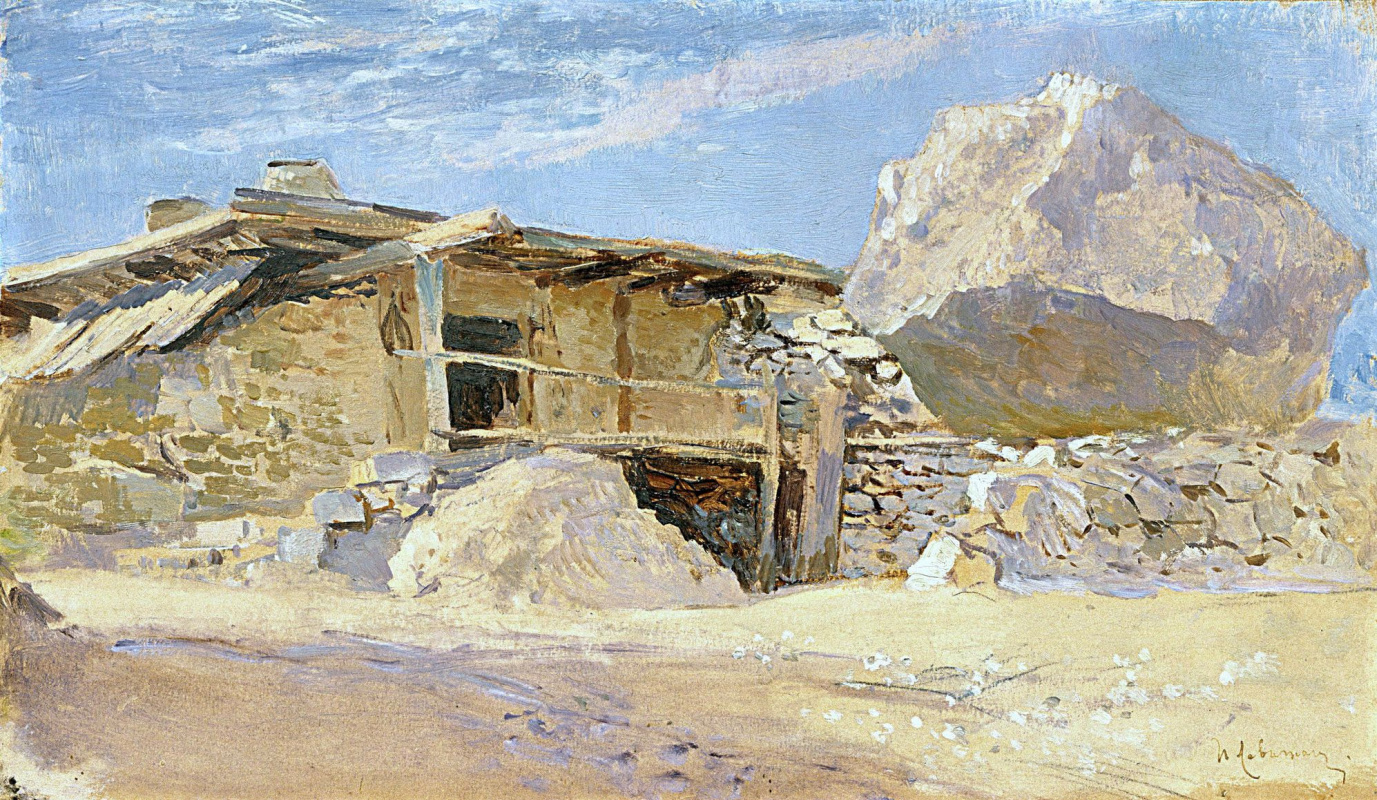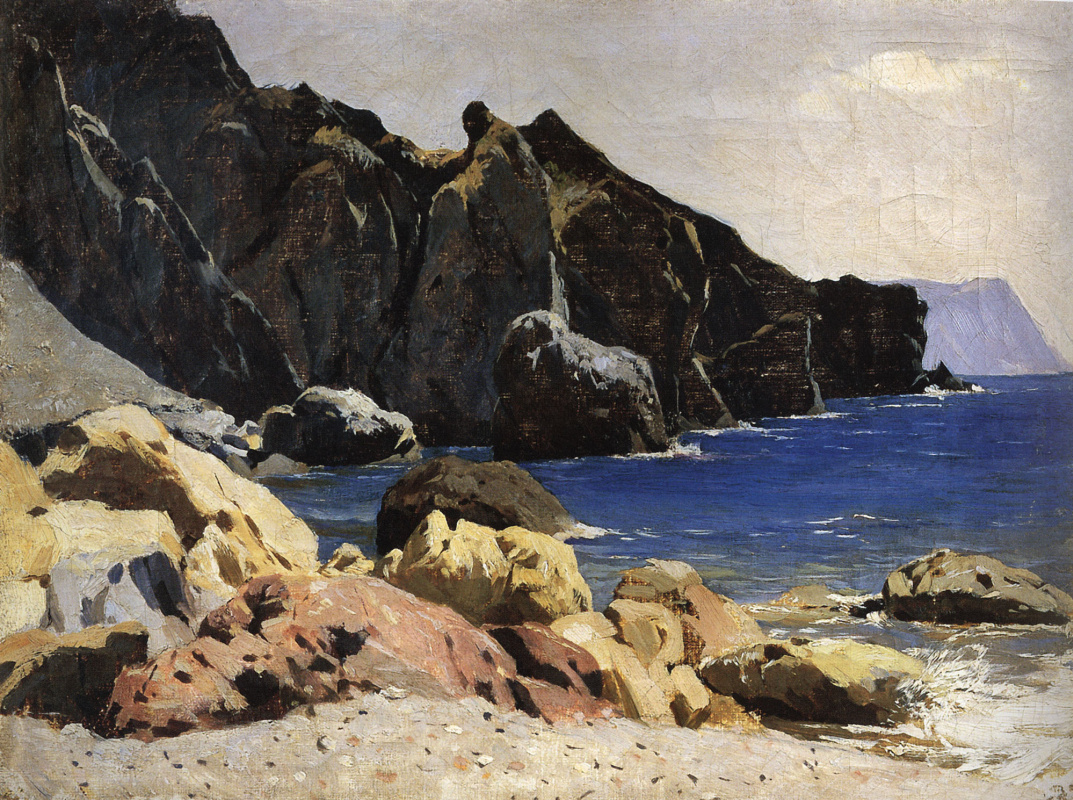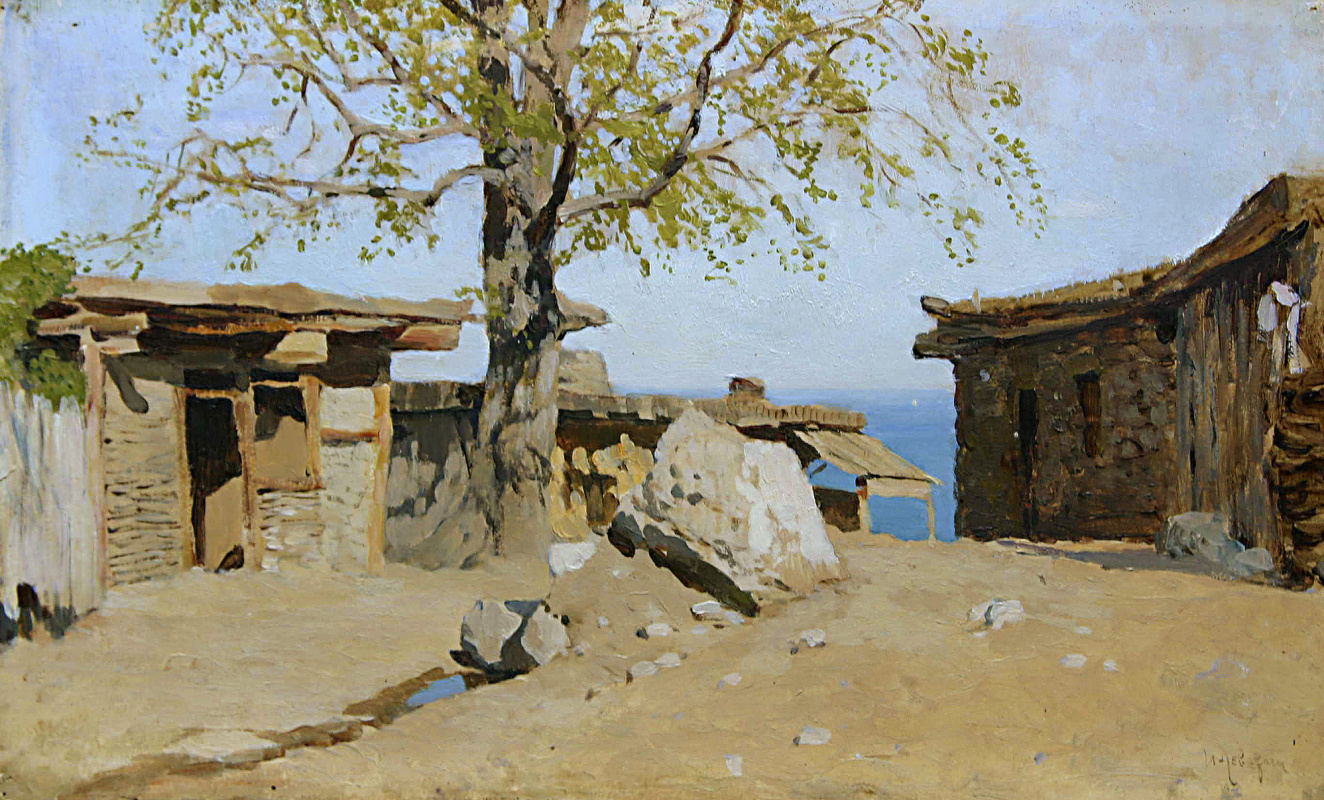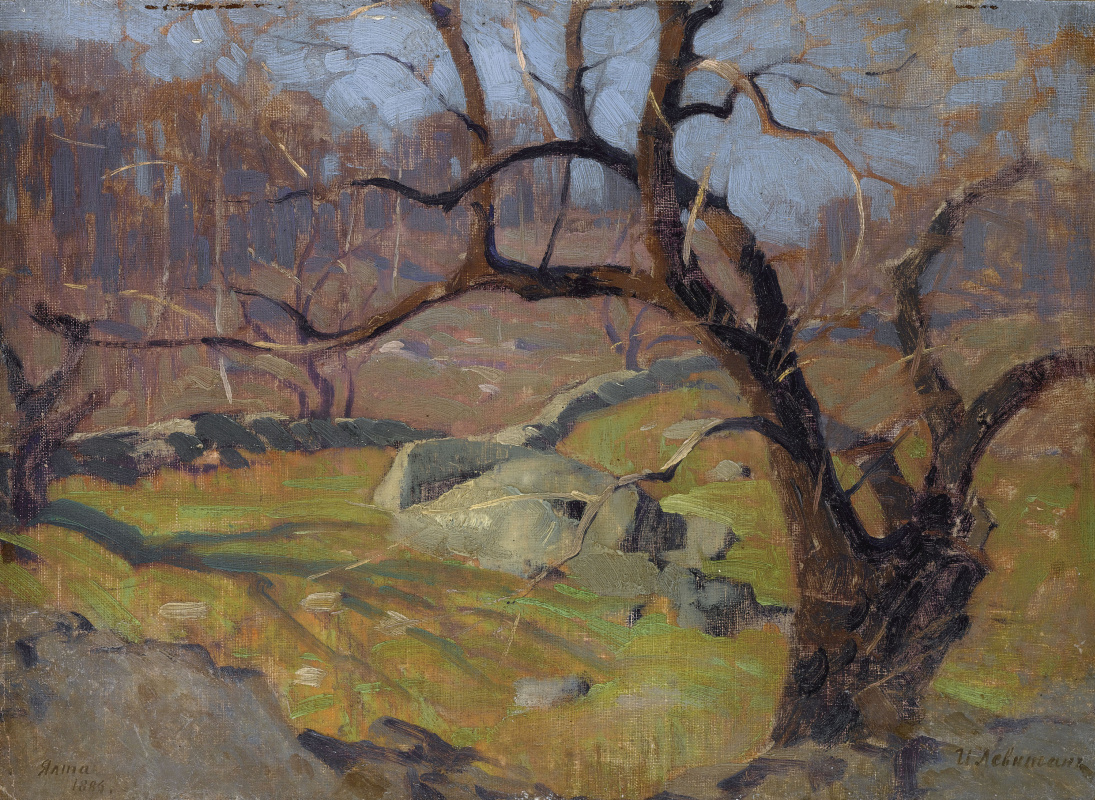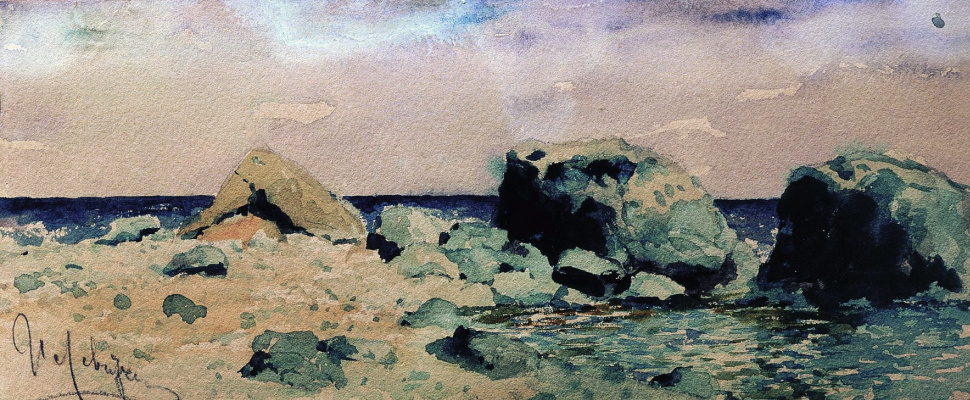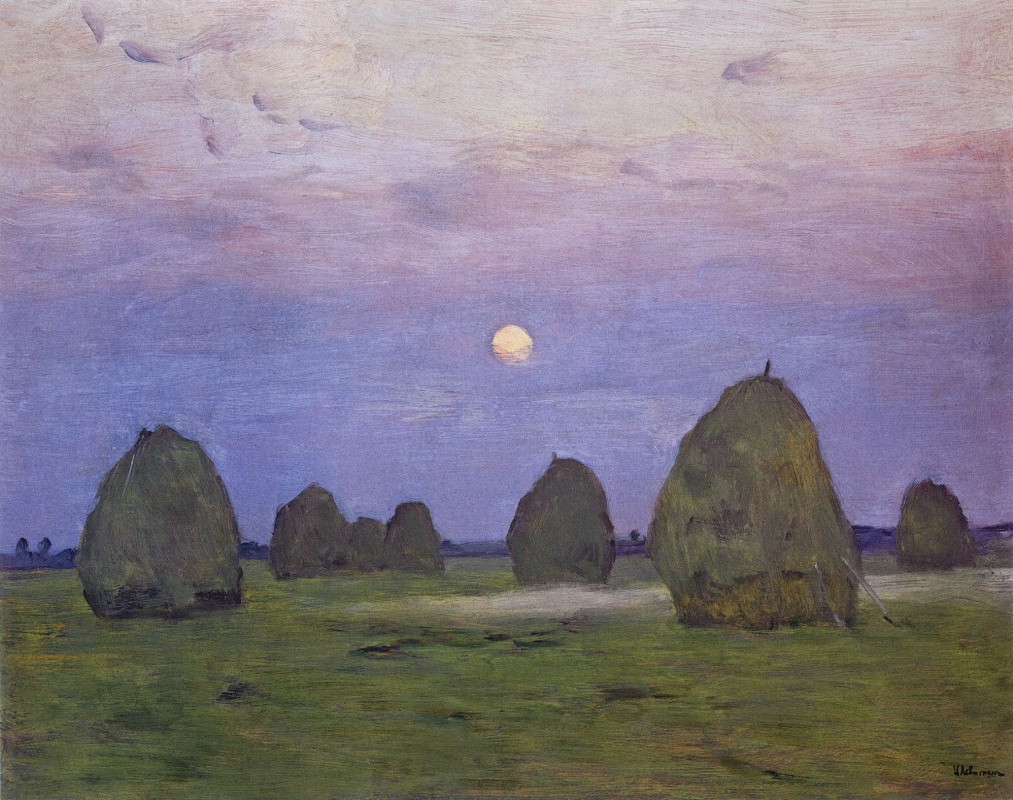Up to twenty five years Isaac Levitanwrote only to Moscow and Moscow region. The geography of his landscapes did not expand for a very simple, banal and sad reason - the artist was poor, almost poor and could not afford long-distance travel. In the early spring of 1886, earning the first serious money for the scenery for the play Private Opera Savva Mamontovbut, Levitan, inspired by the opportunity to escape beyond the limits of the customary world, for the first time in his life he goes to the Crimea.
Street in Yalta
1886, 26.8×22 cm
Levitan did not keep his diaries, and the details of his stay in the Crimea, even for the most meticulous biographers, are still fragmentary. The artist is supposed to have visited Yalta and Gurzuf, Massandra and Alupka. He was young and extremely impressionable, and the southern nature, so different for his usual eye and brush near Moscow, at first could not help shaking Levitan. All was different - the landscape, vegetation, the intensity of colors. Here opened a new reality, poorly presented before it - rocks, Tatar sakli, sea.
"Dear Anton Pavlovich, how the hell is it here!" - enthusiastically wrote Levitan to a friend Chekhov. - Imagine now a bright greenery, a blue sky, and what a heaven! Last night I climbed the rock and looked from the summit to the sea, and you know what, - I cried, and burst into tears sobbing; that's where eternal beauty is and that's where a person feels his total nothingness.
For a month or two Levitan spent in the Crimea. With whom he communicated, where he visited and from whom he stopped to stay, what he saw and what new impressions he owned, we can only guess. But already at the end of April 1886 he sent Chekhov from Alupka a letter, which shows that Levitan's moods have seriously changed:
"Forgive me, dear Anton Pavlovich, that I have not written so long." I did not write to you because I am very lazy to write letters, and besides, I was going to move from day to day. Now I have settled in Alupka. Yalta was extremely bored with me, there is no society, i.e. friends, and the nature here only at first amazes, and after it becomes terribly boring and very much wants to the north. I moved to Alupka later, which worked a little in Yalta, and still a new place, so the impressions of the new ones will probably last for a while, and there certainly in Babkino (see your vile face). Yes, tell me, where did you get that I went with a woman? ..
Already in the middle of May Levitan, fed up with impressions and yearning for "the sweet north", will leave the Crimea to not think about it and return for almost a decade and a half. Next time he will come to Yalta only in 1900, a few months before his death, to say goodbye.
It could be argued that Crimea did not leave any significant traces in Levitan's work, remained in his biography a minor episode, if not for one "but": Crimean sketches made in the spring of 1886 will prove extremely successful - spectators and connoisseurs will buy them directly from the exhibition . And Levitan will be talked about as a man who opened for the Russian public a "new Crimea".
"Dear Anton Pavlovich, how the hell is it here!" - enthusiastically wrote Levitan to a friend Chekhov. - Imagine now a bright greenery, a blue sky, and what a heaven! Last night I climbed the rock and looked from the summit to the sea, and you know what, - I cried, and burst into tears sobbing; that's where eternal beauty is and that's where a person feels his total nothingness.
For a month or two Levitan spent in the Crimea. With whom he communicated, where he visited and from whom he stopped to stay, what he saw and what new impressions he owned, we can only guess. But already at the end of April 1886 he sent Chekhov from Alupka a letter, which shows that Levitan's moods have seriously changed:
"Forgive me, dear Anton Pavlovich, that I have not written so long." I did not write to you because I am very lazy to write letters, and besides, I was going to move from day to day. Now I have settled in Alupka. Yalta was extremely bored with me, there is no society, i.e. friends, and the nature here only at first amazes, and after it becomes terribly boring and very much wants to the north. I moved to Alupka later, which worked a little in Yalta, and still a new place, so the impressions of the new ones will probably last for a while, and there certainly in Babkino (see your vile face). Yes, tell me, where did you get that I went with a woman? ..
Already in the middle of May Levitan, fed up with impressions and yearning for "the sweet north", will leave the Crimea to not think about it and return for almost a decade and a half. Next time he will come to Yalta only in 1900, a few months before his death, to say goodbye.
It could be argued that Crimea did not leave any significant traces in Levitan's work, remained in his biography a minor episode, if not for one "but": Crimean sketches made in the spring of 1886 will prove extremely successful - spectators and connoisseurs will buy them directly from the exhibition . And Levitan will be talked about as a man who opened for the Russian public a "new Crimea".
In the Crimean mountains
1886, 36.5×67 cm
"The New Crimea" to Levitan
Understand what it is - this "new Crimea", discovered by Levitan, is easier if you know how Crimea was familiar and familiar to the lover of painting.
It can not be said that the Russian public before Levitan did not know the picturesque Crimea. There was The Crimea of Aivazovsky- solemnly upbeat, romantic, and in later years the master, alas, mercilessly replicated. Even Crimea was a ceremonial, blooming, radiant and correct, fairly idealized - even now print on postcards, send to in love ladies. Such a picturesque Crimea is usually called - "postcard". A similar Crimea before and after Levitan will be painted by artists Gabriel Kondratenko, Vladimir Orlovsky, Iosif Krachkovsky. Bought such products willingly - to revitalize interiors.
Overcome the textbook beauty of the Crimea in his work tried "brilliant young man" Fedor Vasilyin, but he died too early and did not have much time.
In the Crimean mountains
1873, 116×90 cm
Fresh look of Levitan
Levitan opened a completely different Crimea - not a postcard, not a front door, not a "glossy one."
In his "Sakle in Alupka", "Tatar cemetery" or marine species there is no pathetic pressure, no romantic high-flowness, no special "beauties". Crimean landscapes of Levitan, as the art historian Vladimir Petrov notes, "Imbued with a feeling of calm, thoughtful contemplation".
Tatar cemetery. Crimea
1886, 45×75.2 cm
At the beach. Crimea
1886, 41.3×65 cm
One of the most interesting works of Levitan of the Crimean period - "Sakly in Alupka", stored in the Tretyakov Gallery. How far from the "palace pathetic" habitual for Crimea these wrong lines, rough boards and cumbersome rough stones - and at the same time how much radiantness and lightness in a cheerful combination of light blue and ocher, sand and sky. There are so many new color options in comparison with the earth-green palette of the early Zvenigorod and Ostan landscapes of Levitan! "Working in the Crimea in an open air gave a lot to Levitan, helped enrich his palette, develop a sense of color", - says the biographer of the artist Alexei Fyodorov-Davydov.
Hut in Alupka
1886, 19×33 cm
"Levitan ... was fascinated by the beauty of the southern nature of the sea, flowering almonds, - the artist's friend testifies Mikhail Nesterov. - The elegant motifs of the ancient Tauris with its opal sea, meditative cypresses, with a soft outline of the mountains matched the gentle, melancholy nature of the artist. Returning to Moscow, Levitan put his Crimean sketches on the Periodical Exhibition, at that time the most popular after the Mobile. Etudes were sold out in the very first days ..."
Küste (Krim)
1886, 30×40 cm
Grey day. Mountains. Crimea
1886, 33×65 cm
Crimea. In the mountains
1886, 20×23 cm
Garden in Yalta. Cypress
1886, 20×32 cm
When the lecturer Levitan at the Moscow School of Painting, Sculpture and Architecture, the artist Vasily Polenova few years later will be in the Crimea, he will be amazed at how accurate, thin and faithful to nature was in his Crimean sketches Levitan:
- The more I walk around the outskirts of Yalta, - admitted Polenov, - The more I appreciate the sketches of Levitan. Neither Aivazovsky nor Lagorio, nor Shishkin, nor MyasoedovThey did not give such true and characteristic images of the Crimea as Levitan.
- The more I walk around the outskirts of Yalta, - admitted Polenov, - The more I appreciate the sketches of Levitan. Neither Aivazovsky nor Lagorio, nor Shishkin, nor MyasoedovThey did not give such true and characteristic images of the Crimea as Levitan.
Hof in Jalta
1886, 19×32 cm
Blick in der Nähe von Jalta
1886, 27.8×38.3 cm
In most cases, the Crimean sketches of Levitan did not become the material for the finished paintings. Exceptions very little - for example, grown up from the same etude and significantly enriched in the palette picture "At the Sea. Crimea "(State Russian Museum, St. Petersburg) and executed in the following 1887 rather" composed "than the actual" Crimean Landscape "(Plesk State Museum of History, Architecture and Art, Plyos).
At the beach. Crimea
1886, 41.3×65 cm
Crimean landscape
1887, 73×97 cm
In this picture, which synthesized many of the Crimean impressions of Levitan, the mountainous coast of the Black Sea, the flowery pebbles, the green stones green with moss are depicted. The spectator's glance slides along the surf line into the distance, resting on the majestic outlines of Ayu-Dag with white saklyas at the foots and overgrown cypresses. This is not a marina in the traditional sense - the sea in the Crimean landscape is not the central hero. Always acutely experienced the vastness of the water space and emotionally suppressed by him (this will not only be on the Black Sea, but also when the artist first finds himself on the Volga), Levitan does not seek to capture the vastness or grandeur of the sea. Rather, he is compositionally more important than the sky: these gray and yellowish thin clouds, extremely rich in shades, with bluish breakthroughs, can best convey the mood of a cloudy spring day in the Crimea.
Employees of the museum in Plyos, where the "Crimean landscape" is stored, managed to consider even the images of people in the motley of his foreground: "On the beach - two small figures that are so rare in the Levitan landscapes. He avoided pictures of people or even more genre scenes, trying to "humanize" nature with his experiences and feelings. In the figures, male and female, you can guess the artist himself in a black suit and a red Turkish fez and his companion, most likely SP Kuvshinnikov ".
Employees of the museum in Plyos, where the "Crimean landscape" is stored, managed to consider even the images of people in the motley of his foreground: "On the beach - two small figures that are so rare in the Levitan landscapes. He avoided pictures of people or even more genre scenes, trying to "humanize" nature with his experiences and feelings. In the figures, male and female, you can guess the artist himself in a black suit and a red Turkish fez and his companion, most likely SP Kuvshinnikov ".
"January in the Crimea. On the Black Sea shore, winter comes as if for fun ... "
The end of December, 1899. The last days of the last month of the last year of the outgoing century. 13 years have passed since Levitan's Crimean spring. All these years he did not remember about the Crimea - too many layers of impressions, too much work, too stormy, boiling with love passions and from time to time plunging into hopeless melancholy life. He worked in the Moscow and Tver provinces, explored and depicted the Volga, the Volga cities and monasteries - and became the most famous Russian landscape painter. He traveled three times abroad: he saw works of the Impressionists and his favorite artist, Corot, in France, he wrote the spring in Italy and the Mont Blanc mountain range, he was bored and again timid before the gloomy might of the sea and mountains in Finland.
But in the last days of the year and the century, not knowing yet, but seeming to foresee that this will be the last year of his short 39-year life, Isaak Levitan goes to the Crimea.
One could say - and literally loop the story - that Levitan was again called Crimean nature. But in reality it was not so. Not nature, not rocks, not the sea, but people close to whom he had never been in his life, attracted Levitan to the Crimea. Chekhov and his sister Maria Pavlovna, MaPa, as her family name, a woman who once, the only one of all, Levitan made a proposal of the hand and heart. It was them, Anton and Masha, their closest friends, who wanted to see the deadly sick Levitan.
One could say - and literally loop the story - that Levitan was again called Crimean nature. But in reality it was not so. Not nature, not rocks, not the sea, but people close to whom he had never been in his life, attracted Levitan to the Crimea. Chekhov and his sister Maria Pavlovna, MaPa, as her family name, a woman who once, the only one of all, Levitan made a proposal of the hand and heart. It was them, Anton and Masha, their closest friends, who wanted to see the deadly sick Levitan.



In the photo from left to right: Isaak Levitan, Maria and Anton Chekhov.
A year ago, Chekhov bought a site in Yalta. High above the sea, next to the Tatar cemetery. He built a house there - the now famous "White Cottage", collecting, as before, under his roof, relatives and friends. And on the wall in one of the rooms, among many other pictures and photographs, still hung the youthful portrait of the sick Levitan, which many years ago Nikolai's older brother, Chekhov, wrote.
A year ago, Chekhov bought a site in Yalta. High above the sea, next to the Tatar cemetery. He built a house there - the now famous "White Cottage", collecting, as before, under his roof, relatives and friends. And on the wall in one of the rooms, among many other pictures and photographs, still hung the youthful portrait of the sick Levitan, which many years ago Nikolai's older brother, Chekhov, wrote.
Levitan came from Moscow weather, dressed in winter - the Chekhovs poured out to meet him without outer clothing, laughing and friendly, as always. January in the Crimea seemed unbelievably warm. Evergreen plants made us doubt that winter was on the street.
In Yalta with Levitan there were curiosities. He was sometimes loudly recognized on the streets - he was already used to Chekhov here, but Levitan was a "visiting celebrity". Once Chekhov took him to a picture shop on the Yalta embankment. Looking at the rudely painted "beautiful" landscapes, Levitan began to resent - who, they say, needs such art and why does it exist like that?
When they came out, Chekhov scolded Levitan for indivisibility - the pictures were written by the owner of the shop, standing right behind the counter. Levitan was horrified at his sharpness, demanded an immediate return, trying to portray the ease, told me that the host heard, they say, in fact everything is not so bad in these nice pictures, everything is hopeless, and even glimpses of art ... He sometimes offended his beloved - But to offend someone intentionally, purposely for Levitan it is inconceivable.
In Yalta with Levitan there were curiosities. He was sometimes loudly recognized on the streets - he was already used to Chekhov here, but Levitan was a "visiting celebrity". Once Chekhov took him to a picture shop on the Yalta embankment. Looking at the rudely painted "beautiful" landscapes, Levitan began to resent - who, they say, needs such art and why does it exist like that?
When they came out, Chekhov scolded Levitan for indivisibility - the pictures were written by the owner of the shop, standing right behind the counter. Levitan was horrified at his sharpness, demanded an immediate return, trying to portray the ease, told me that the host heard, they say, in fact everything is not so bad in these nice pictures, everything is hopeless, and even glimpses of art ... He sometimes offended his beloved - But to offend someone intentionally, purposely for Levitan it is inconceivable.

Chekhov on the balcony of his house in Yalta. 1899.
Photo by: chekhov-yalta.org
Maria Pavlovna accompanied Levitan on long walks. He was sorry for him: Levitan grew very noticeably older, quickly tired. Disease - an extension of the aorta and rheumatic myocarditis - it was senseless to hide behind jokes and gay chatter. A heart disease betrayed itself with tumbled eyes, a yellowed face, excruciating breathlessness.
One day Levitan asked Masha to go up with him to the mountains. He was unwell in the morning, he pressed his heart and he explained:
- I so want to go where the air is easier, where it will be easy to breathe.
They climbed the Yalta mountain: it is still as sweet, attractive as it used to be, and he - slowly, with difficulty, leaning on a stick. Before Levitan, a landscape was spread that resembled the one that, once, on its first visit to the Crimea, suppressed it with its greatness - the dense color of the sea, merging with the vast sky. And Levitan again did not cope with himself:
- Marie! How do not you want to die! .. How terrible it is to die and how heart aches! ..
They returned home, where the fireplace was heated, and Chekhov remembered tea after tea, chuckling as 13 years ago Levitan wrote to him that a common friend, the architect Fyodor Shekhtel, did not invent that Levitan would fall in love with the southern nature and exchange Moscow suburbs for the Crimea: "Tell the Shekhtel ... do not worry," I love the north more now than ever, I only now understood it ... ".
Levitan was smiling. He asked Masha to bring a piece of cardboard and paint. Masha herself was fond of painting - once upon a time she was taught by Levitan ("Does m-lle Marie work?" He asked Chekhov. - Tell me that I worked hard. And then I'll come and put in a corner "). Paper and paint were found quickly. On an elongated piece of cardboard that evening, Levitan repeated his painting "Rick" - since then she was left hanging in the Chekhov's living room, fixed in an oblong niche over the fireplace.
Photo by: chekhov-yalta.org
Maria Pavlovna accompanied Levitan on long walks. He was sorry for him: Levitan grew very noticeably older, quickly tired. Disease - an extension of the aorta and rheumatic myocarditis - it was senseless to hide behind jokes and gay chatter. A heart disease betrayed itself with tumbled eyes, a yellowed face, excruciating breathlessness.
One day Levitan asked Masha to go up with him to the mountains. He was unwell in the morning, he pressed his heart and he explained:
- I so want to go where the air is easier, where it will be easy to breathe.
They climbed the Yalta mountain: it is still as sweet, attractive as it used to be, and he - slowly, with difficulty, leaning on a stick. Before Levitan, a landscape was spread that resembled the one that, once, on its first visit to the Crimea, suppressed it with its greatness - the dense color of the sea, merging with the vast sky. And Levitan again did not cope with himself:
- Marie! How do not you want to die! .. How terrible it is to die and how heart aches! ..
They returned home, where the fireplace was heated, and Chekhov remembered tea after tea, chuckling as 13 years ago Levitan wrote to him that a common friend, the architect Fyodor Shekhtel, did not invent that Levitan would fall in love with the southern nature and exchange Moscow suburbs for the Crimea: "Tell the Shekhtel ... do not worry," I love the north more now than ever, I only now understood it ... ".
Levitan was smiling. He asked Masha to bring a piece of cardboard and paint. Masha herself was fond of painting - once upon a time she was taught by Levitan ("Does m-lle Marie work?" He asked Chekhov. - Tell me that I worked hard. And then I'll come and put in a corner "). Paper and paint were found quickly. On an elongated piece of cardboard that evening, Levitan repeated his painting "Rick" - since then she was left hanging in the Chekhov's living room, fixed in an oblong niche over the fireplace.

"We have Levitan, - wrote Chekhov wife Olga Knipper. - On my fireplace he painted a moonlit night during haymaking. Meadow, mop, far away forest, all must be the moon. "
Photo by: chekhov-yalta.org
Photo by: chekhov-yalta.org
Twilight. Stack
1899, 59×74 cm
Crimea Levitan on fresh impressions did not write - the peninsula did not become for him "his". Work at this time the artist could only with the support of medicines and through force. Having met the new Chekhovs in the company of the year 1900, a couple of weeks later he will sail away on a steamer from Yalta, return to Moscow, and in summer Levitan will not.
The last year of the artist's life is dated several spring Crimean landscapes. Performed in his late "impressionistic" manner, they - like an unexpected memory of the distant spring of 1886, when Levitan, having first gained freedom from circumstances, broke out into the unknown Crimea.
The last year of the artist's life is dated several spring Crimean landscapes. Performed in his late "impressionistic" manner, they - like an unexpected memory of the distant spring of 1886, when Levitan, having first gained freedom from circumstances, broke out into the unknown Crimea.
Spring in Crimea
1900, 55.3×71.7 cm
Spring in the Crimea. Etude
1900, 23.7×32 cm
Author: Anna Yesterday











